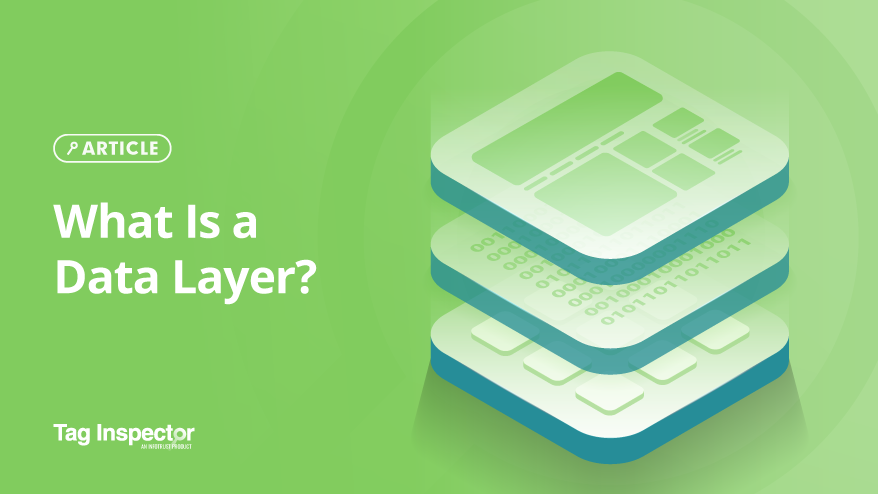Simply put, a data layer is a JavaScript object that exists in the source code of a website and serves as a conduit for passing information from that site to your tag management system. It contains variables that hold specific data points you need in order to gain insight on your campaigns, such as product IDs, page names, or user interactions. Triggers in your tag configurations can be activated based on the values of these variables, allowing you to collect and process data consistently and effectively.
When you send website data to a vendor, your tag management system must source that data from somewhere. If there is not a centrally located data layer structure, that often means you must scrape the data from wherever it exists in the source code, a practice known as DOM scraping. This could mean pulling it from the paragraph text, image file names, or linked URLs, which can be messy and unreliable.
While DOM scraping may seem like a convenient solution for data collection because it does not require a heavy lift upfront, it does come with its own set of challenges that increase over time:
- Lack of Scalability: Scraping data from various places within the source code is a very brittle and unreliable source. As websites and apps grow in complexity, manual scraping becomes increasingly difficult to maintain.
- Data Collection Failures: Relying solely on DOM scraping puts your data collection initiatives at risk. Any changes to the website structure or content can result in data loss or errors during extraction, leading to unreliable insights.
- Developer Support and Maintenance: Any breakages or updates in your data collection require developer attention. This can create dependencies and delays in your processes, limiting agility and responsiveness.
As an alternative to DOM scraping, you can implement a data layer, which is a much more dynamic solution, meaning it can adapt and scale with change. This ability to accommodate change, among other reasons, is what makes it a more logical choice to use in the long term:
- Improved Data Organization: Instead of relying on scattered and inconsistent sources, a data layer provides a centralized repository for all necessary information. This centralization ensures consistency and reliability in data collection.
- Enhanced Data Governance and Security: By pulling all data from one controlled and defined structure, which data gets exposed can be managed more effectively, reducing the risk of leaks or unauthorized access.
- Scalability and Flexibility: As your website or app evolves, the data layer can easily adapt to changes without disrupting the data collection processes, making it future-proof.
To fully leverage the benefits of a data layer, it is essential to understand some of the best practices for its implementation. Following these best practices can help to guarantee that you maximize the value from the data it provides:
- Consistent and Deliberate Design: Carefully design and implement your data layer, confirming it captures all necessary data points and follows a consistent architecture. Clear documentation and proper labeling are crucial for ease of management.
- Version Control: Implement version control to track changes and maintain a historical record. This enables you to roll back or review previous versions of the data layer, verifying data consistency and accuracy.
- Regular Review and Updates: Conduct periodic reviews to identify and address any necessary changes or updates required. This proactive approach helps maintain the integrity and relevance of the data being collected.
- Stakeholder Involvement: Collaborate with key stakeholders, including marketers, analysts, and developers, to ensure that the data layer meets the specific data collection needs of your organization. By involving all relevant parties, you can maintain alignment and minimize any hiccups in the installation process.
When you weigh the cost and benefits of implementing a data layer versus continuing to use a labor-intensive method like DOM scraping, the long-term advantages of making the switch become apparent fairly quickly:
- Time and Cost Savings: Having a data layer streamlines data collection and maintenance processes, reducing the need for labor-intensive DOM scraping and ongoing developer support. Development hours are expensive and being able to redistribute them to something more proactive will give your users a better experience with your site.
- Improved Data Consistency: By having a centralized and standardized approach to data collection, you can have more faith in the improved accuracy and reliability of insights derived from your data.
- Enhanced Agility and Adaptability: As a more flexible and scalable solution, a data layer future-proofs data collection processes, allowing you to quickly and efficiently respond to your constantly-evolving data requirements.
Ultimately, using a data layer is a simple and clean method for maintaining the quality of data on your site and making certain it will always be available when you need it. Although DOM scraping may seem like it is saving you time, as implementation of a data layer does require some effort at first, it has the potential to cost you a lot more time down the road as your site and data availability changes. Think of a data layer like a high-interest investment in your future—the rewards will absolutely be greater than the cost.
Whether it is minimizing time chasing down breakages or increasing the effectiveness of your campaigns by providing consistent, accurate data, implementing a data layer may not necessarily make money, but it certainly does save it. Taking the time to make sure that your data collection is future-proofed allows you to spend more time doing what matters most: using your data. Stop fighting against your processes and use the time and resources you get back to create actionable insights with confidence.
